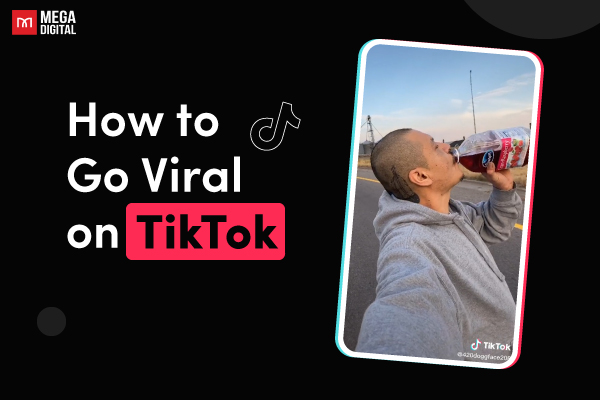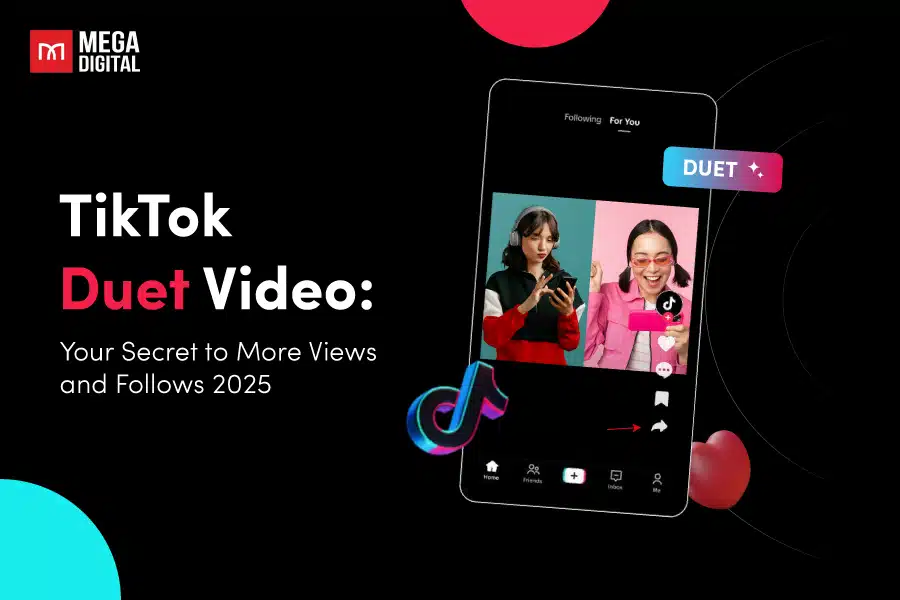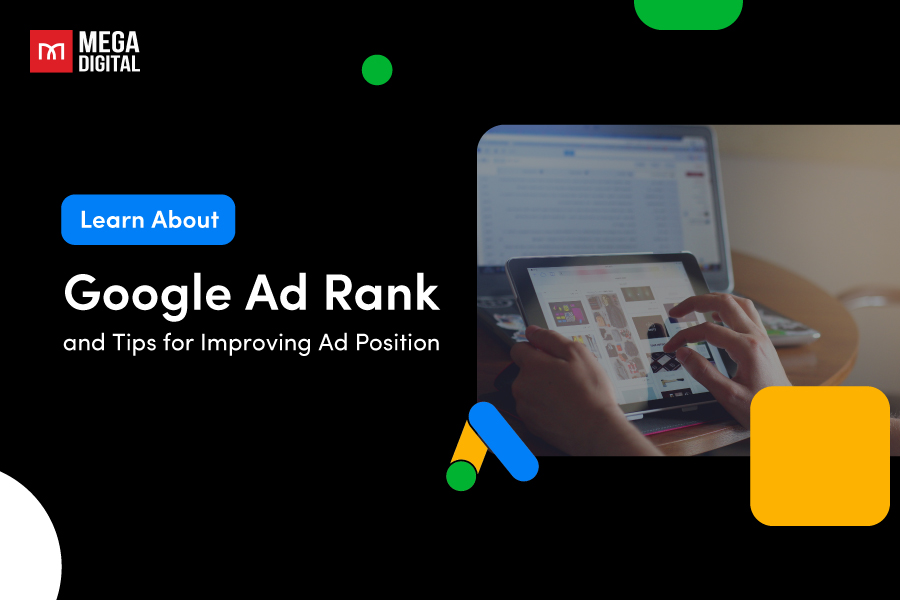Facebook Ads is a powerful tool, widely adopted by advertisers across industries. With its low barrier to entry, even new advertisers can jump in and start running campaigns almost instantly. However, common mistakes can lead to wasted budgets and missed opportunities. This blog post will guide you through the 10 most frequent Facebook ad mistakes, helping you avoid them to maximize the potential of your campaigns.
- 9+ Most Common Facebook Ad Mistakes
- 1. Choose the wrong advertising objective
- 2. Fail to use the Facebook Pixel
- 3. Boost posts instead of creating an ad campaign
- 4. Target too big or too small of an audience
- 5. Fail to research your ad target audience
- 6. Neglect to control your budget
- 7. Direct to an irrelevant landing page
- 8. Use ineffective ad creatives
- 9. Test too many ad elements simultaneously
- 10. Do not track your ad campaigns
- How to Avoid Facebook Ad Mistakes in the First Place?
9+ Most Common Facebook Ad Mistakes
Facebook Ads, when used correctly, can be highly effective in extending brand reach and achieving your business goals.
However, making crucial mistakes in your Facebook ad campaigns can lead to poor performance, wasted ad spend, and disappointing results. Instead of generating leads and sales, these errors can limit reach, reduce engagement, and ultimately hurt your return on investment.
According to Search Engine Land, businesses waste an average of 25% of their ad spend due to poor targeting and campaign mismanagement across social media platforms, including Facebook.

If you’re reading this, you’re likely experiencing some issues with your Facebook Ads. To help you identify and correct these problems, let’s explore 10 most common Facebook ad mistakes, and practical ways to fix them.
1. Choose the wrong advertising objective
One of the most frequent mistakes in Facebook advertising is selecting an objective that doesn’t match the purpose of your campaign.
Objectives are the desired outcomes of your ads, and should align closely with your broader campaign goals to achieve meaningful results. Otherwise, you risk targeting the wrong audience, misallocating budget, and falling short of your intended outcomes.
For example, you’re running a Facebook ad for an online store and want to drive purchases. However, instead of selecting “Conversions” as the objective (which optimizes for actions like purchases), you choose “Traffic.”
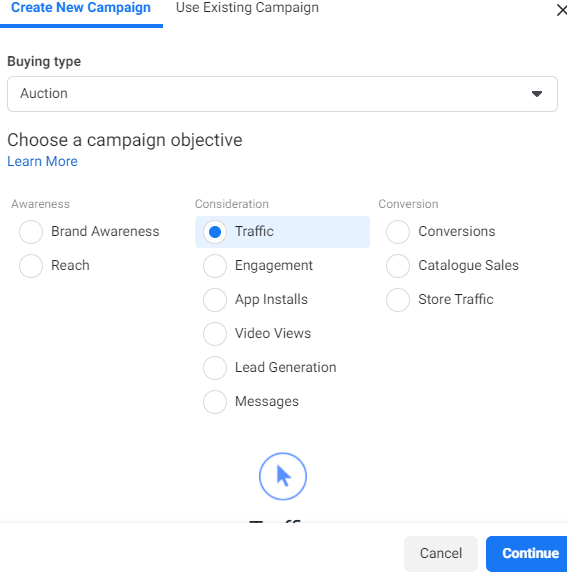
While “Traffic” will bring more visitors to your site, it won’t specifically target users who are likely to complete a purchase. As a result, your ads may attract clicks but won’t necessarily convert them into sales.
How to fix this:
It’s quite easy to fix this mistake.

Define your campaign goals by asking yourself these questions:
- What exactly do you want to achieve with your ad campaign?
- Are you aiming for more leads, higher revenue, sign-ups, or similar outcomes?
Once your goals are clear, match them with the appropriate objectives.

2. Fail to use the Facebook Pixel
Facebook Pixel is one of the main reasons why Facebook Ads are so powerful.
The Facebook Pixel is a small piece of code added to your website that lets you track visitor behavior and actions. The possibilities for using this data to enhance your campaigns are limitless.
Failing to utilize this tool is one of the most common mistakes beginners make with Facebook Ads, as it limits insights into audience engagement and reduces your ability to optimize for higher conversions.
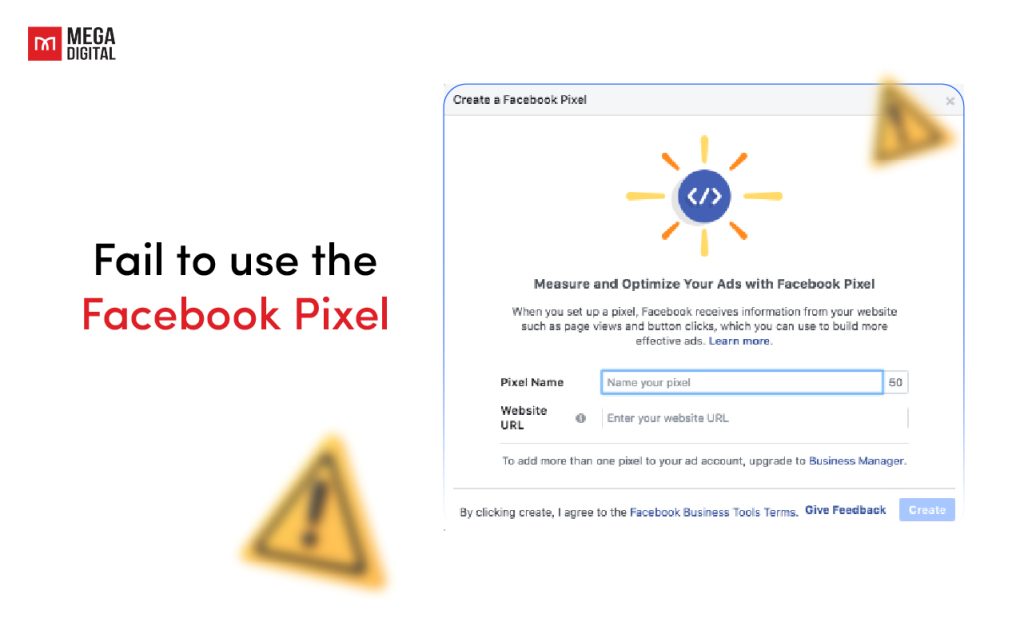
How to fix this:
To start using the Facebook Pixel, follow these steps:
- Install the Pixel: In Ads Manager, go to “Events Manager” > “Connect Data Sources,” copy the code, and add it to your website’s header.
- Define key events: Set up actions you want to track (like purchases or sign-ups) for meaningful data collection.
- Verify the Pixel: Use the Pixel Helper extension to ensure it’s tracking correctly.
- Create retargeting audiences: Build custom audiences based on site behavior for targeted retargeting.
- Use data to optimize: Leverage Pixel data to refine targeting, track conversions, and improve ad performance.
3. Boost posts instead of creating an ad campaign
If you’ve spent any amount of time on Facebook, you’ve likely seen the “Boost Post” option underneath the posts on your business’s Facebook page.
You click on it and think, “I’ve started advertising on Facebook.” But that’s not the case.
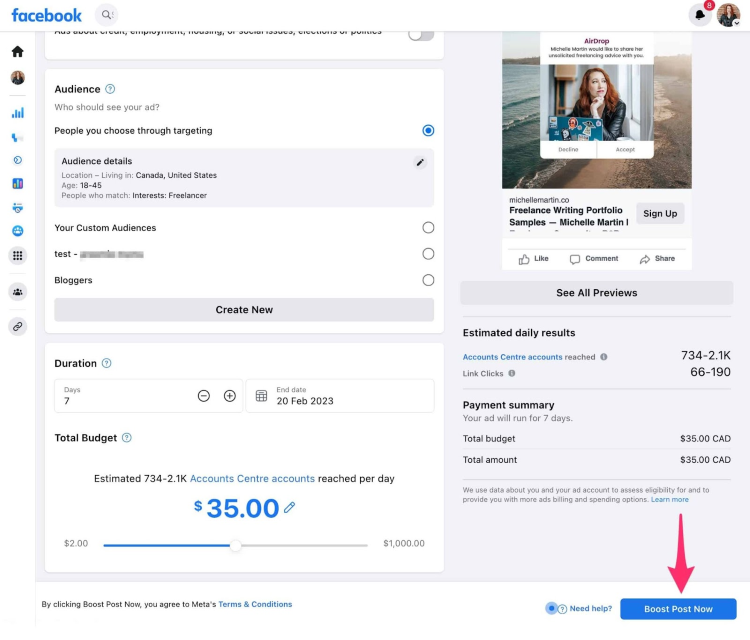
Although Facebook suggests that boosting your post could help you reach thousands, it’s best to avoid using this option.
When you rely solely on boosted posts, you miss out on Facebook Ads Manager’s advanced options, such as precise audience targeting, custom placements, and optimized bidding strategies.
How to fix this:
Instead of boosting posts, make an ad of your post in Facebook’s ad manager, or even create a whole new ad campaign. This way, you can take advantage of advanced targeting options, select precise objectives that align with your goals, and customize placements for optimal performance.
4. Target too big or too small of an audience
Another common Facebook ad mistake revolves around audience size. But why is getting the audience size right so important?
If your audience is too small, it can be challenging to fully utilize your ad budget, or your ads may appear too frequently to the same users, leading to ad fatigue on Facebook. On the other hand, if your audience is too large, you risk spending more on reaching people who may not be a good fit for your offer, lowering your ad’s effectiveness.

How to fix this:
While there’s no one-size-fits-all rule for the perfect audience size, it largely depends on factors like your campaign objective, industry, and budget. Generally, an ideal audience size is around 500,000 to 2 million people. For businesses with a larger budget, targeting an audience of up to 2.5 million can work well.
>>> Read more: Mastering Facebook Ad Targeting with These 6 Useful Strategies
5. Fail to research your ad target audience
Failing to research your target audience is a critical Facebook ad mistake that can severely impact campaign performance.
Without a clear understanding of who your audience is, what they’re interested in, or their pain points, trying to reach the right people with your ads can feel like trying to find a needle in a haystack.

Your ads may reach people who aren’t interested, resulting in low engagement and wasted ad spend. This oversight can lead to poor targeting settings, irrelevant messaging, and ultimately, a lower return on ad spend.
How to fix this:
To define your audience, follow these steps:
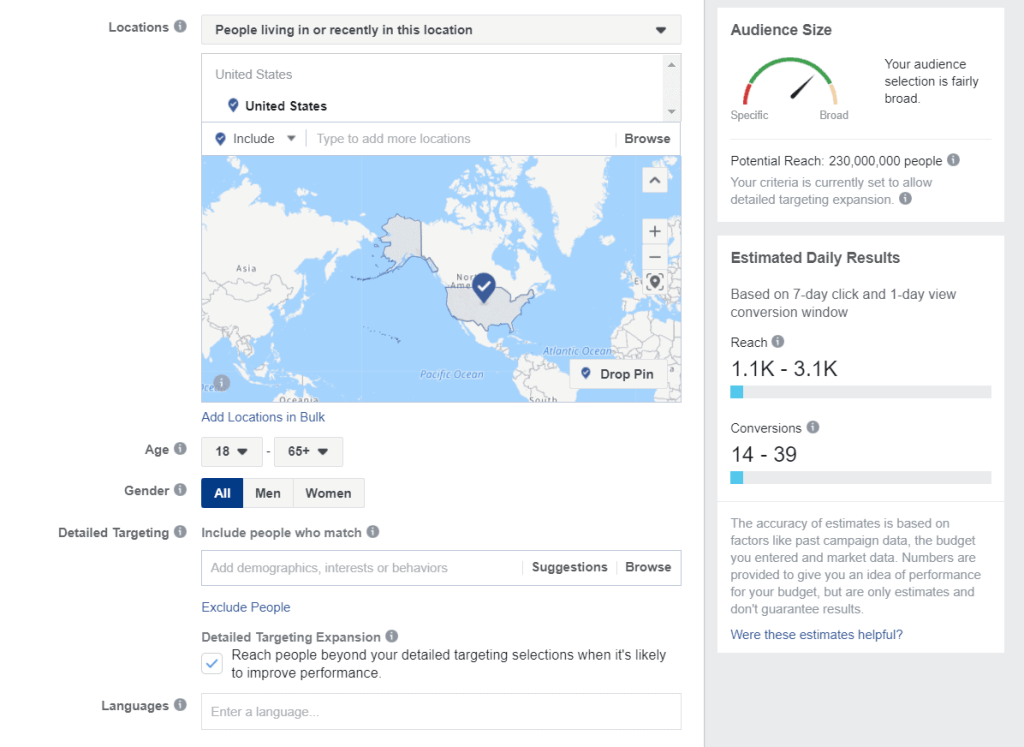
- Define your ideal customer: Identify key characteristics of your target audience, including demographics (age, gender, location) and psychographics (interests, behaviors, pain points) to create a clear customer profile.
- Use Facebook Audience Insights: Explore Audience Insights in Facebook Ads Manager to analyze existing data on your current audience, competitors’ audiences, and market trends.
6. Neglect to control your budget
With Facebook advertising, you have to decide how much you want to spend on your ads. However, many businesses make the mistake of not controlling their budget.
This mistake has two key parts that both impact how effectively your ad budget is used:
- Neglecting to set a defined budget
- Failing to monitor and adjust bidding and budget
Without a set budget, you risk overspending, as there’s no cap to control your ad spend and ensure sustainability over time. Even with an initial budget, overlooking bid adjustments can lead to inefficient spending or missed opportunities to optimize performance.
How to fix this:
Start by setting a realistic budget and committing to it. Keep an eye on your bid amounts and budget performance to track where your clicks come from and their cost. This monitoring allows you to adjust your targeting, helping reach a more qualified audience.
Also, think about changing your budget type. Facebook provides daily and lifetime options.

If you’re using a lifetime budget but want to extend your ad’s duration, switching to a daily budget can help stretch your investment further.
7. Direct to an irrelevant landing page
This Facebook ad mistake is actually quite common among other paid advertising platforms, like TikTok, Google, etc.
No matter how much effort you’ve put into crafting an excellent ad, the sale ultimately happens on the page where you direct your ad traffic. If your landing page doesn’t align with your ad, it can create confusion for visitors.
And when people feel confused, they will not make perform the desired action.
How to fix this:
Keep your ads and landing pages coordinated, from images, fonts, colors to its purpose, everything!
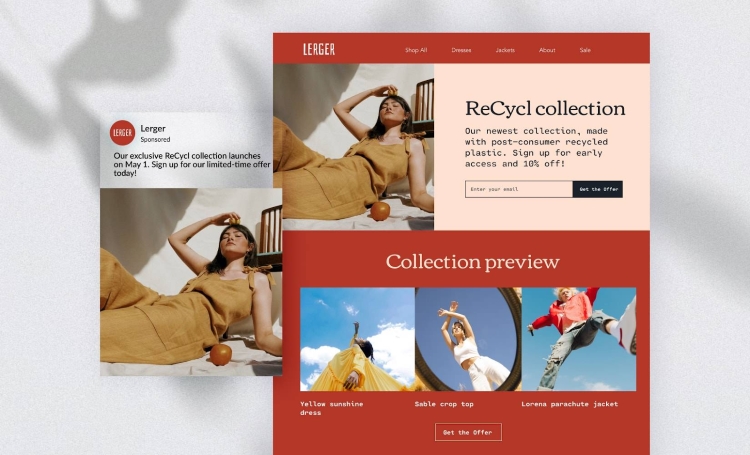
This helps you create a cohesive message that conveys a level of quality and attention-to-detail that your audience will appreciate.
8. Use ineffective ad creatives
Some advertisers believe that as long as the message is clear, the quality of ad creatives isn’t crucial. They argue that audiences care more about the content than the presentation and will engage if the information is relevant to them.
However, using ineffective ad creatives, such as ads with too much text, low-quality images, or poorly designed visuals, can greatly hinder the performance of your Facebook campaigns.
Ads overloaded with text or featuring blurry, unappealing images are less likely to capture attention, and they may even be penalized by Facebook’s algorithm, leading to reduced reach.
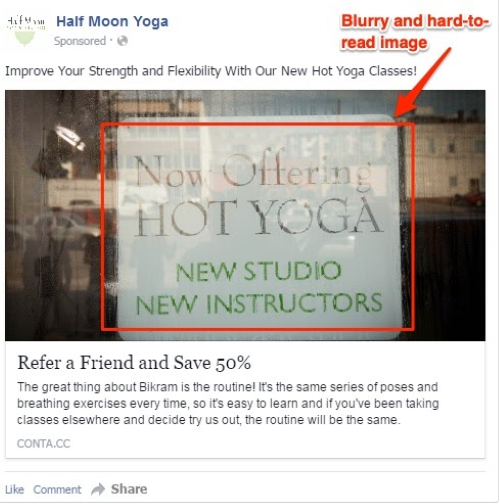
How to fix this:
You can follow these Facebook ad creatives requirements:
- High-resolution visuals: Use clear, professional-quality images or videos in high resolution to make sure your ads look sharp on all devices.
- Minimal text in images: Facebook recommends keeping text minimal in your visuals to avoid clutter and improve reach.
- Clear and simple messaging: Ensure the main message is straightforward and easy to understand within a few seconds.
- Brand consistency: Keep fonts, colors, and design elements consistent with your brand.
- Attention-grabbing elements: Use bold visuals, bright colors, or an engaging layout to stand out in the feed.
9. Test too many ad elements simultaneously
The next common Facebook advertising mistake involves ad testing. As you monitor your campaigns, you may notice areas for improvement, leading you to make multiple adjustments at once to test their overall impact.
The issue with this approach is that it prevents you from understanding the effect of each individual change. If your ad performs better, you won’t know which adjustment contributed to the improvement.
How to fix this:
The best way to address this mistake is to test changes one at a time, or test through different ad groups. Create a small variety of ads with variations in image, video, text, or links.
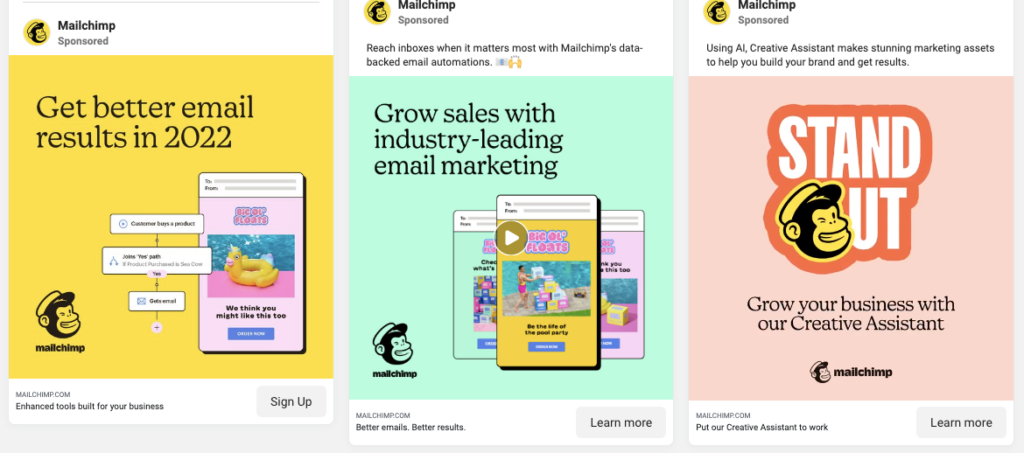
By making and testing single adjustments, you can clearly see how each tweak affects ad performance, helping you identify what drives positive or negative results.
10. Do not track your ad campaigns
Failing to track your Facebook ad campaigns is a critical mistake that can lead to poor performance and wasted budget.
Many companies think their work is finished once their ads are live, assuming they can simply let the campaign run on its own.
However, this approach often results in wasted ad spend. Without monitoring campaign performance, you’ll overlook valuable opportunities to enhance your ads. Consequently, this can lead to missed leads and revenue for your business.
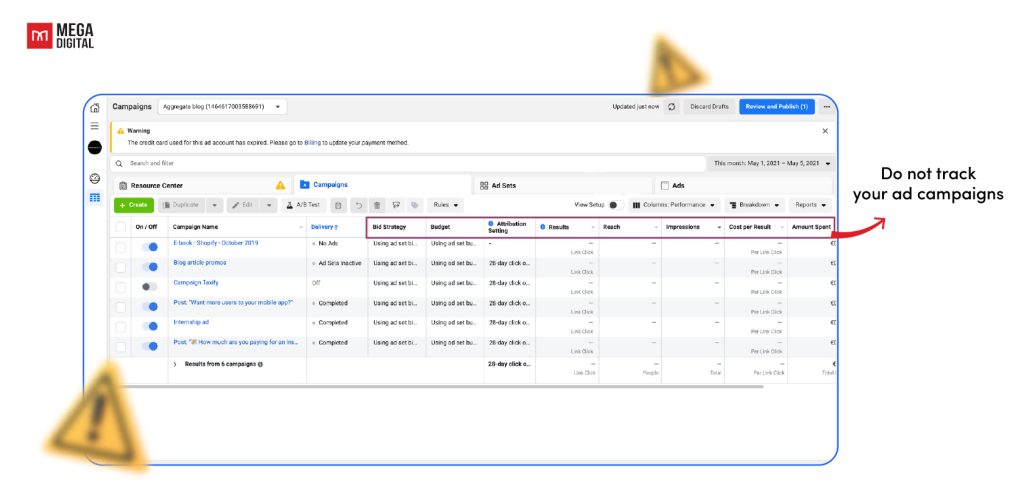
How to fix this:
Just start tracking your campaigns to gain insight into where your ads are performing well and where they need improvement.
But which Facebook ad metrics should you monitor to assess your campaign’s success? The common ones to keep an eye on include:
- Frequency
- Click-through rate (CTR)
- Conversion rate
- Cost per click (CPC)
- Return on ad spend (ROAS)
How to Avoid Facebook Ad Mistakes in the First Place?
You know what, prevention is better than cure! It’s always better to avoid mistakes from the outset than to try to fix them later, when your budget has been drained and your ad effectiveness has declined.
Preventing Facebook ad mistakes starts with a solid foundation and proactive approach. Here are some tips to help you avoid common pitfalls and maximize the effectiveness of your Facebook ads from the start:
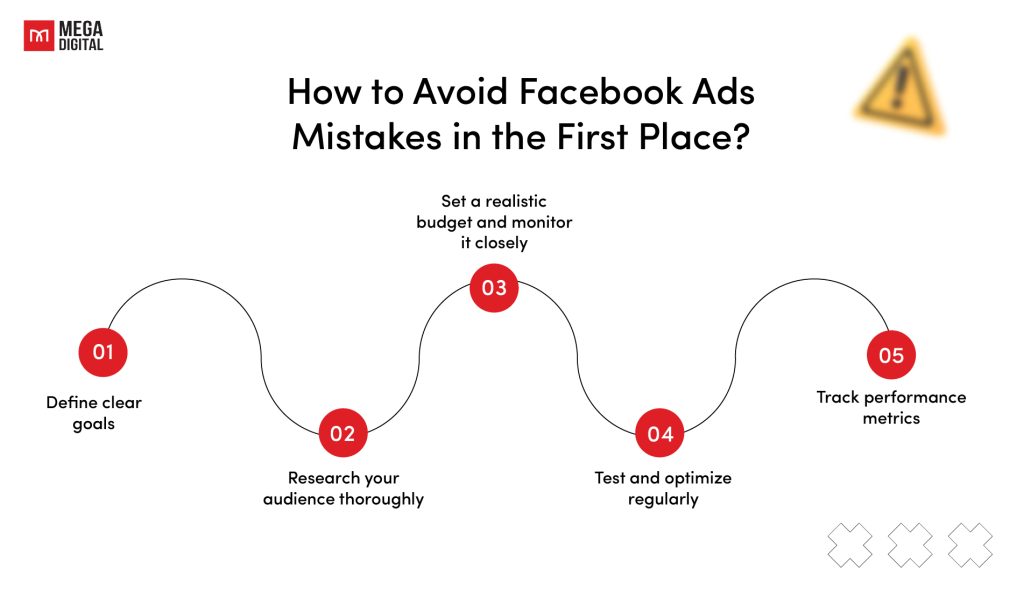
- Define Clear Goals: Start by setting specific, measurable objectives for each campaign, such as brand awareness, lead generation, or conversions.
- Research Your Audience Thoroughly: Understanding who your ideal customers are, what they’re interested in, and their online behaviors is key to successful targeting.
- Set a Realistic Budget and Monitor It Closely: Establish a budget that reflects your goals and audience size, and keep an eye on how your budget is being spent. Regularly monitoring your ad spend ensures that you’re maximizing returns and can adjust if needed.
- Test and Optimize Regularly: Instead of making multiple changes at once, test one element at a time to understand what works best. Run A/B tests to see which creatives, audiences, or formats drive the best results.
- Track Performance Metrics: Keep an eye on key metrics such as CTR, conversion rate, and ROAS.
Wrap-up
In conclusion, avoiding these common Facebook ad mistakes can make a significant difference in the success of your campaigns. I hope that this guide has provided you with valuable insights and actionable steps to enhance your Facebook advertising efforts and achieve your marketing goals.







